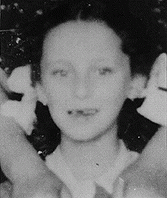You searched for: 澳门威尼斯人网址【手动输入∶___bet126.net___】最新地址请收藏,澳门威尼斯人网址是多少,澳门威尼斯人全部网址,澳门新威尼斯人的网址,澳门威尼斯人网址玩法,澳门威尼斯人网址44,澳门威尼斯人开户网址。
<< Previous | Displaying results 1-50 of 430 for "澳门威尼斯人网址【手动输入∶___bet126.net___】最新地址请收藏,澳门威尼斯人网址是多少,澳门威尼斯人全部网址,澳门新威尼斯人的网址,澳门威尼斯人网址玩法,澳门威尼斯人网址44,澳门威尼斯人开户网址。" | Next >>
-
Jewish Uprisings in Ghettos and Camps, 1941–44
ArticleUnder the most adverse conditions, Jewish prisoners initiated resistance and uprisings in some of the ghettos and camps, including Bialystok, Warsaw, Treblinka, and Sobibor.
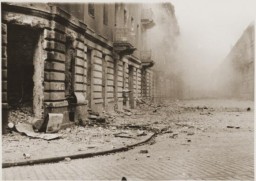
-

-
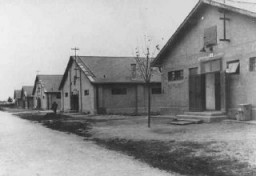
-
Vyhne camp
PhotoJewish inmates at forced labor in the Vyhne concentration camp in Slovakia, 1941–44.

-

-
Jewish girls in hiding in a convent
PhotoA group of Jewish girls hiding, under assumed identities, in a convent. Ruiselede, Belgium, 1943-44.
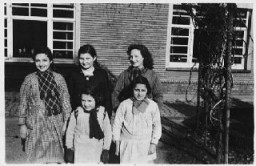
-
Forced labor in the Siemens factory
PhotoPrisoners at forced labor in the Siemens factory. Auschwitz camp, Poland, 1940–44.
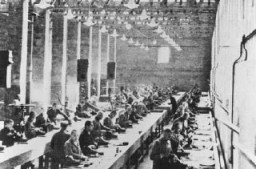
-
Three Jewish partisans
PhotoThree Jewish partisans in the Wyszkow Forest near Warsaw. Poland, between 1943–44.
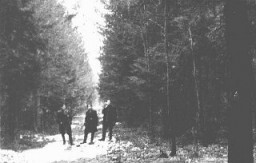
-
Barbed-wire surrounding the Plaszow camp
PhotoA section of barbed-wire fencing surrounding the Plaszow camp. Plaszow, Poland, 1943-44.

-
Deportation from Westerbork
PhotoDeportation from the Westerbork transit camp. Members of the Jewish police are seen in the photograph. The Netherlands, 1943–44.
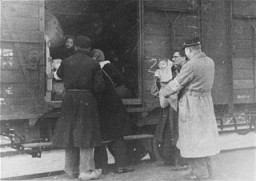
-
"Gypsy camp" in the Lodz ghetto
Photo"Gypsy camp" area in the Lodz ghetto. Roma (Gypsies) were confined in a segregated block of buildings. Poland, 1941–44.

-
The Drancy transit camp
PhotoThis multistory complex served as the Drancy transit camp. The overwhelming majority of Jews deported from France were held here prior to their deportation. Drancy, France, 1941–44.
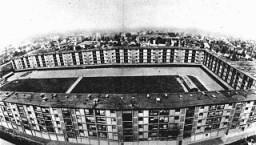
-
Living quarters for Soviet prisoners of war
PhotoDugouts which served as living quarters for prisoners in Stalag 319—a Nazi-built camp for Soviet prisoners of war. Chelm, Poland,1941–44.
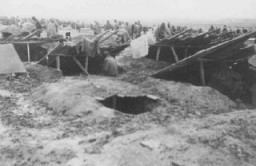
-
Jewish children who were sheltered in Le Chambon-sur-Lignon
PhotoJewish children sheltered by the Protestant population of the village of Le Chambon-sur-Lignon. France, 1941–44.
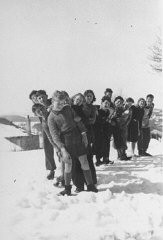
-
Deportation of Jews from the Lodz ghetto to the Chelmno killing center
PhotoJews from the Lodz ghetto are loaded onto freight trains for deportation to the Chelmno killing center. Lodz, Poland, 1942–44.

-
United Nations Relief and Rehabilitation Administration - Photographs
Media EssayThe United Nations Relief and Rehabilitation Administration (UNRRA) was created at a 44-nation conference in 1943. Its mission was to provide economic assistance to European nations after World War II and to repatriate and assist refugees.
-
Portrait of a boarding school class in which a Jewish boy was hidden
PhotoClass photograph of students at the San Leone Magno Fratelli Maristi boarding school in Rome. Pictured in the top row at the far right is Zigmund Krauthamer, a Jewish child who was being hidden at the school. Rome, Italy, 1943–44.

-
A wounded partisan receives medical attention
PhotoA wounded partisan is treated in a field hospital belonging to the Shish detachment of the Molotov brigade. Among those pictured are Dr. Ivan Khudyakov, the brigade's physician (second from the right), and Fanya Lazebnik (Faye Schulman), a photographer and partisan nurse (left). The wounded partisan's name is Sergei. Pinsk, 1942–44.
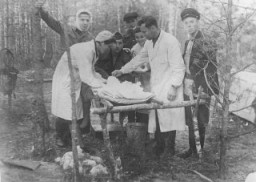
-
United Nations Relief and Rehabilitation Administration
ArticleThe United Nations Relief and Rehabilitation Administration’s mission was to provide economic aid to European nations and assist refugees after World War II.
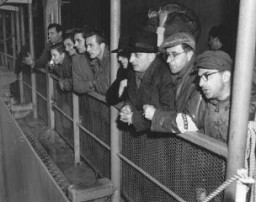
-
Deggendorf Songbook
Timeline EventDecember 1, 1945. On this date, survivors of the Deggendorf displaced persons camp gave a songbook to the UNRRA director Carl Atkin.
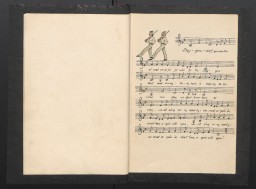
-
Raizel Kisielnicki
ID CardRaizel lived with her husband, Mojsze, and their three children in the small, predominantly Jewish town of Kaluszyn, which was 35 miles east of Warsaw. By the 1930s, Mojsze owned a grocery store, a restaurant, and a gas station, all of which were located together on the heavily traveled main road. The family lived in rooms in the same building as their business. 1933-39: Every day Raizel prepares the roast goose served in the family's restaurant. They have a bustling business, as many truck drivers stop…

-
Gassing Operations
ArticleThe Nazis used poisonous gas to murder millions of people in gas vans or stationary gas chambers. The vast majority of those killed by gassing were Jews.
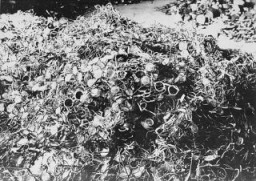
-
Spiritual Resistance in the Ghettos
ArticleCultural and educational activities, clandestine documentation and religious observances. Learn more about these and other types of spiritual resistance in ghettos in Nazi-occupied areas.

-
Jewish Community of Munkacs: An Overview
ArticleLearn about the Jewish community of Munkacs, famous for its Hasidic activity as well as its innovations in Zionism and modern Jewish education.
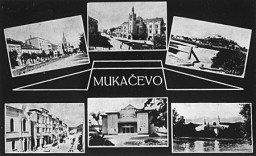
-
Bosnia
ArticleIn July 1995, Bosnian Serb forces killed as many as 8,000 Bosniaks from Srebrenica. It was the largest massacre in Europe since the Holocaust.
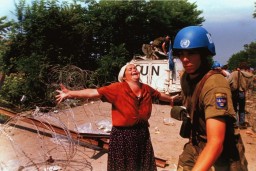
-
Righteous Among the Nations
ArticleRighteous Among the Nations are non-Jewish individuals honored by Yad Vashem, Israel's Holocaust memorial, for risking their lives to aid Jews during the Holocaust.

-
First Letter to All Judges
ArticleLearn how the "First Letter to all Judges" increased the pressure on German judges to give verdicts and sentences according to Nazi principles and ideology.
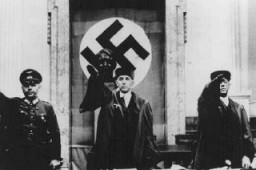
-
Gideon Frieder
ArticleExplore Gideon Frieder’s biography and learn about his experiences as a child during the Holocaust in Slovakia.
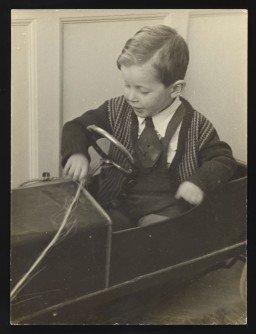
-
Lewek Szabasson
ID CardLewek and his five brothers and sisters were born to religious Jewish parents in the town of Kozienice, situated in east central Poland near a birch forest. Lewek's father owned a sawmill, and when Lewek and his brothers were grown, they helped their father manage the family business. 1933-39: When Lewek was 15 he attended an agricultural school near Kozienice, because he wanted to immigrate to Palestine [Aliyah] to work the land. But after the Nazis rose to power in Germany in 1933, immigration…

-
Chaya Medalion
ID CardChaya and her brother and two sisters were raised in a religious, Yiddish-speaking home in the town of Kozienice, situated in east central Poland near a large birch forest. As a child, Chaya learned Hebrew. She attended Polish public schools and graduated at 14. Her father owned a factory that produced handmade shoes. 1933-39: Chaya was active in the Zionist movement, through which she met her boyfriend, Lewek Szabasson. Chaya and Lewek would stroll on Kozienice's main promenade which was at the…
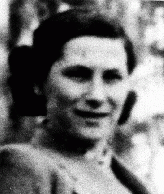
-
Israel Milkow
ID CardIsrael was born to a religious Jewish family living in the town of Slonim. He was called Yisroel by his Yiddish-speaking parents. Israel's father, Lazar Milkow, was a baker who supported his family on a meager income. 1937-39: Israel's grandparents and many of his mother's relatives lived in a nearby village called Kaslovchina. Each summer one of the Milkow boys was invited to stay in Kaslovchina with their Uncle Herschel who worked as a farmer and horse trader. In September 1939 Slonim became part of the…
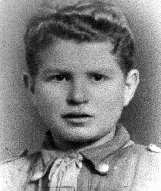
-
Edith Goldman Bielawski
ID CardEdith's parents owned a cotton factory in the town of Wegrow [in Poland]. The Goldmans were a religious family, and raised Edith, her brother and three sisters to strictly observe the Sabbath, Jewish holidays and the dietary laws. 1933-39: Edith attended public school, and also studied at the Beis Yakov religious school for girls where she learned Hebrew, the Bible and Jewish history. Her favorite hobby was knitting, and after finishing secondary school she learned the quilt-making trade. In the…
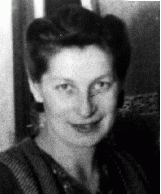
-
Tonie Frederika Kaufmann Soep
ID CardTonie's parents came to the Netherlands from Germany in the 1880s, and their six children were born in Amsterdam. As a child, Tonie studied the piano, and she excelled in French. When she married Abraham Soep, a diamond manufacturer, Tonie adopted her husband's observant Jewish practices. Their three children were born in 1919, 1923, and 1924. 1933-39: Tonie's husband served for many years as the president of the Amsterdam Jewish community. The Soeps had a large and comfortable home. Tonie and Abraham…
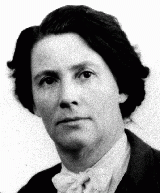
-
Abraham Soep
ID CardAbraham, known as "Bram," was born to a religious Jewish family in Amsterdam. After graduating from high school, Bram went into the diamond business with his father. By 1924 he and his wife, Tonie, had three children. Bram served as president of the Amsterdam Jewish community. 1933-39: The Soeps had a large and comfortable home. Bram and his wife often traveled abroad, and each summer the family rented a home near the seashore in Zandvoort. In 1937 Bram's son Benno joined him in the diamond…

-
Albert Gani
ID CardAlbert and his family lived in Preveza, a town with a Jewish population of 300 that was located on the Ionian seashore. Albert's father had a small textile shop. The Ganis were of Romaniot descent, Jews whose ancestors had lived in Greece and the Balkans for more than a thousand years. 1933-39: After graduating from high school, Albert assisted his father in the family textile shop. A quiet and reserved young man, Albert enjoyed spending time at home with his family. Albert loved taking excursions with…
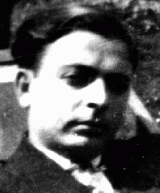
-
Joseph Gani
ID CardJoseph and his family lived in Preveza, a town with a Jewish population of 300 that was located on the Ionian seashore. Joseph's father had a small textile shop. The Ganis were of Romaniot descent, Jews whose ancestors had lived in Greece and the Balkans for more than a thousand years. 1933-39: Joseph attended Greek public school in Preveza. He also received a religious education; the local rabbi would come to the public school for several hours a week to give religious instruction to the Jewish students.…
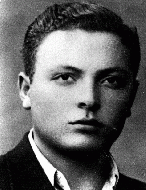
-
Jovanka Jovicic Babunovic
ID CardJovanka was one of six children born to Serbian Orthodox parents in a small town in the Bosnian part of Yugoslavia. Her parents were prominent Serbian nationalists. After Jovanka completed middle school in Foca, she moved with her parents in 1912 to the multi-ethnic city of Sarajevo. There she met and married Marko Babunovic in 1916. The couple raised three children. 1933-39: Jovanka was an active member of the Serbian Orthodox Church. Her husband was a prosperous businessman, and she was active in…
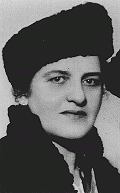
-
Mirjana Babunovic Dimitrijevic
ID CardMirjana was the second of three children born to well-to-do Serbian parents in the capital of Bosnia, in central Yugoslavia. Her father was a successful businessman and prominent Serbian nationalist. Like her parents, Mirjana was baptized in the Serbian Orthodox faith. Mirjana attended elementary school in the multi-ethnic city of Sarajevo. 1933-39: While in secondary school, Mirjana studied foreign languages and toured western Europe. In 1938 she graduated. That fall she enrolled as a student of English…
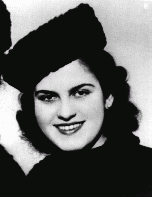
-
Mara Jovicic Popovic
ID CardMara was one of six children born to Serbian parents. The family lived in the small town of Foca in the region of Bosnia. Like her parents, Mara was baptized in the Serbian Orthodox faith. She grew up in Foca and in the Bosnian capital of Sarajevo, where she completed secondary school. In 1930 she married Rajko Popovic, a circuit court judge. The couple had no children. 1933-39: In 1934 Rajko completed a judicial tour of duty in Foca, and the couple moved to Sarajevo, the capital of Bosnia. Mara and Rajko…

-
Leon Franko
ID CardLeon was born to a large, Ladino-speaking, Sephardic-Jewish family. The Frankos lived in a large house in ethnically diverse Bitola, a town located in the southern part of Yugoslav Macedonia, near the Greek border. Leon's father, Yiosef, was a successful fabric merchant. The Frankos' children attended Yugoslav public schools where they learned to speak Serbian. 1933-39: Upon completing his schooling, Leon became a fabric merchant in Bitola. A handsome man from a well-to-do family, Leon was popular. His…
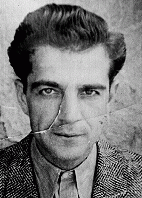
-
Ida Edelstein
ID CardIda, born Ida Kohn, was the oldest of four children born to a Jewish family in the village of Hostoun, near Prague. Her father owned a grocery store in the village, and also recorded the birth, death and marriage certificates in the Jewish community. In 1912 Ida married Josef Edelstein and they moved to Vienna. By 1920 the couple had a son, Wilhelm, and a daughter, Alice. 1933-39: In March 1938 the Germans annexed Austria. In the next few weeks, Ida, along with other Jews, was forced to scrub sidewalks.…
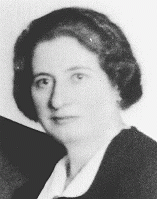
-
Rosa Israel Waldhorn
ID CardRosa was one of 14 children born to religious Jewish parents in the village of Yasinya at a time when it was known as Korosmezo and was part of Hungary. During World War I, she married Michael von Hoppen Waldhorn, an officer in the Austro-Hungarian army who was based near Yasinya. During the 1920s they moved to Paris, where they raised three children. 1933-39: The Waldhorn family's life in Paris was very different from their life in Hungary and Czechoslovakia. Rosa's husband made a good living, and he…
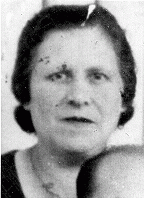
-
Rebecca Pissirilo
ID CardRebecca was the oldest of three children born to Ladino-speaking, Sephardic-Jewish parents. The Pissirilos lived in Kastoria, a small town in the mountainous region of Greek Macedonia near the Albanian border. Rebecca's father was a successful fabric merchant. The Pissirilo children attended public schools. 1933-39: After finishing elementary school, Rebecca went on to study at secondary school. She liked to sing and enjoyed studying. Rebecca kept a diary, like some of the other girls in her class. The…
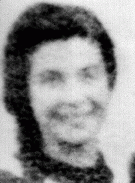
-
Marta Herman
ID CardThe younger of two daughters, Marta was raised by Hungarian-speaking Jewish parents in Kosice, a city in Slovakia. Marta attended a Jewish elementary school. Her father ran a small grocery store. 1933-39: After Marta finished elementary school, she began secondary school. The language of instruction was Slovak and Jews faced no discrimination until November 1938 when Hungarian troops marched into southern Slovakia. With Germany's blessing, Kosice became part of Hungary and was renamed Kassa. Their new…

-
Maria Orlicka
ID CardMaria was born to a poor family in the industrial town of Jaworzno, not far from Krakow, in southwestern Poland. Both of Maria's parents worked. Like her parents, Maria was baptized in the Roman Catholic faith. 1933-39: Maria took care of the house when her parents were working. She was 11 years old when the Germans invaded Poland on September 1, 1939. German troops reached Jaworzno that same month. Jaworzno was in an area of Poland that became formally annexed to Germany. 1940-44: The Germans arrested…
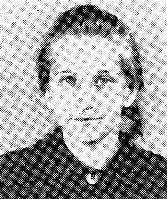
-
Henny Schermann
ID CardHenny's parents met in Germany soon after her father emigrated from the Russian Empire. Henny was the first of the Jewish couple's three children. The family lived in Frankfurt am Main, an important center of commerce, banking, industry and the arts. 1933-39: After the Nazis came to power, they began to persecute Jews, Roma (Gypsies), men accused of homosexuality, people with disabilities, and political opponents. In 1938, as one way of identifying Jews, a Nazi ordinance decreed that "Sara" was to be…

-
Johann Stossier
ID CardJohann was born to Catholic parents in the part of Austria known as Carinthia, where he was raised on the family farm. Johann enjoyed acting and belonged to a theater group in nearby Sankt Martin, which also happened to have a Jehovah's Witness congregation. He became a Jehovah's Witness during the late 1920s, actively preaching in the district around Sankt Martin. 1933-39: Johann continued to do missionary work for the Jehovah's Witnesses even after this was banned by the Austrian government in 1936. The…

-
Lisa Dawidowicz
ID CardLisa was born to a Jewish family in the small city of Ostrog in southeastern Poland. Her parents operated a grocery out of their residence; the front half of the house was a store and the rear half was their home. Ostrog was an important center of Jewish religious learning in Poland, and by 1933 Jews made up almost two-thirds of the city's total population. 1933-39: Lisa's family was religious and they regularly attended services. Lisa studied at a Polish school until the Soviets arrived in September…

-
Janka Glueck Gruenberger
ID CardJanka was one of seven children raised in a Yiddish-and Hungarian-speaking household by religious Jewish parents in the city of Kosice. In 1918, when she was 20 years old, Kosice changed from Hungarian to Czechoslovak rule. Three years later, Janka married Ludovit Gruenberger, and their three children were born Czech citizens. 1933-39: Janka was an accomplished milliner, and she helped her husband run a tailoring business from their apartment. Like many Jews in Kosice, Janka and Ludovit were upset when…
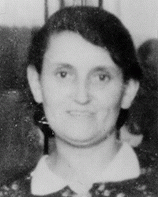
-
Zuzana Gruenberger
ID CardZuzana was the youngest of three children born to Hungarian-speaking Jewish parents in the city of Kosice. She was the baby of the family, and they called her Zuzi. Her father was a tailor whose workshop was in the Gruenbergers' apartment. 1933-39: In November 1938, when Zuzana was 5, Hungarian troops marched into Kosice and made it a part of Hungary. The Hungarians changed the name of the city to Kassa. The Hungarian government was friendly to Nazi Germany and introduced anti-Jewish laws in…
